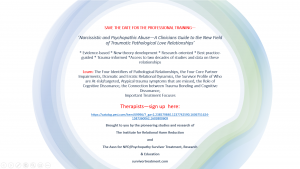By Joan-Marie Lartin, PhD, RN
Last week we looked at neurofeedback training as a method to calm the brain and reduce a wide-ranging variety of symptoms associated with PTSD. A person with PTSD has the unfortunate challenge of living with constant hormonal and neurotransmitter disruption. Why is this the case, even when the trauma is in the past? We know from Sandra’s work and that of others in the field of personality disorders, that the trauma does not necessarily stop once the relationship is over.
There are many legitimate sources of ongoing re-traumatization for the person formally involved with a disordered individual. For example, legal matters, shared custody of children, the process of rebuilding a life, all contain unique triggers.
But how can we understand the extent to which the person’s body continues to be in overdrive, even when these triggers are reduced? One answer lies in an understanding of what happens physically to a person under constant stress and/or trauma.
The cell membranes in various parts of the nervous system become literally worn out over time and unresponsive, which means the normal shut-off process in those experiencing constant stress is not working. Thus, we have a biochemical and nervous system on overload, spinning down into further and further dis-regulation in the absence of effective interventions.
This is one reason why we see neurotransmitter and cortisol imbalances, and imbalances in brain functioning in PTSD. The brainwaves of persons with PTSD are often characterized by a great deal of activity in the zones related to anxiety, intense emotions, overthinking (obsessing) and hypervigilance. There is usually reduced activity, and therefore reduced functioning, in areas associated with memory, focus, analytic capability, and the ability to relax. The regions associated with sleep are usually disrupted, as is the ability to ‘be in the body.’ The implications for ongoing emotional, physical and interpersonal problems are clear.
Neurofeedback training, which takes about 30-40 minutes per session, can help the nervous system to get back into balance. Most clients find some relief after 2-3 sessions, and may do as many as 30 or 40 sessions over the course of a year. Many find that about 20 sessions makes a big difference in their ability to get on with their lives. The cost varies from region to region, as does the availability of insurance coverage.
This site will help you find a practitioner, using your geographic location: http://directory.eeginfo.com.
(**If we can support you in your recovery process, please let us know. The Institute is the largest provider of recovery-based services for survivors of pathological love relationships. Information about pathological love relationships is in our award-winning book, Women Who Love Psychopaths, and is also available in our retreats, 1:1s, or phone sessions. See the website for more information.)






